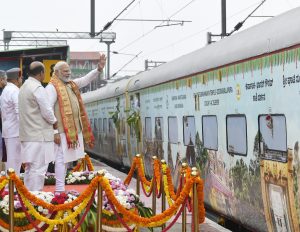India’s Prime Minister Narendra Modi is perpetually in election mode. Despite being in power for eight years with no threat from a fragmented opposition, he is preoccupied with election campaigns for state assemblies throughout the year,
In the northern state of Himachal Pradesh, which voted in state assembly elections recently, Modi courted voters assiduously. Delivering a signed letter to 1.5 million households in Himachal he urged them to vote back to power the ruling Bharatiya Janta Party (BJP) in the state. This unusual step of an incumbent prime minister personally appealing to voters on behalf of his party for a state assembly election was preceded by the inauguration of a blitzkrieg of infrastructure projects.
To counter the effects of anti-incumbency in Himachal, Modi went on a ribbon cutting spree. Sample this: on October 13, he flagged off the Vande Bharat express train, inaugurated the new Indian Institute of Information Technology (IIIT), laid foundation stones for a Bulk Drug Park for pharmaceutical ingredients and two hydropower projects, and launched the third phase of the Pradhan Mantri Gram Sadak Yojana for rural road connectivity in the state.
En route to an election rally in Himachal, Modi stopped his convoy to give way to an ambulance in Chambi. The BJP went on a publicity overdrive, promoting a video clip of this on its official social media handles and hailing him as the country’s “pradhan sewak” (literally prime servant) or the one at the forefront of serving the people of India.
Political opponents lambasted Modi for his theatrics to hog television news headlines. Social media was filled with memes of this “stage-managed election stunt,” which included camera footage from even inside the prime minister’s vehicle.
The script is no different in Modi’s home state of Gujarat, which will vote on December 1 and 5. The BJP has been in power in Gujarat for 27 years and Modi was chief minister for four terms here before becoming prime minister in 2014. Modi is determined to retain power in Gujarat and is the face of the BJP in the polls, be it on posters, at rallies or at big-ticket announcements. He formally launched the party’s poll campaign at a high-voltage election rally in the state with the poll slogan, “Aa Gujarat mein banavyu che” (We have made this Gujarat).
While Modi dominates the BJP campaign, Bhupendra Patel, who was installed as chief minister only two months ago after the unceremonious exit of former Chief Minister Vijay Rupani and his cabinet, is hardly visible.
Everything that Modi does is with the camera in mind. When a suspension bridge in Morbi in Gujarat collapsed recently due to the negligence of the municipal authorities, leaving over 140 people dead, Modi went on a much-publicized visit under the full glare of television cameras to meet the injured victims.
Modi’s propensity for the limelight has drawn criticism. Newly appointed Congress party President Mallikarjun Kharge said that Modi has a habit of inaugurating the smallest project and taking credit for it. “He is going around the country showing the green flag for every one of these trains,” Kharge said, referring to Modi’s serial inauguration of the superfast Vande Bharat express trains across the country. Kharge pointed out that as railway minister under the Congress-led United Progressive Alliance government, he too had launched 27 such trains but never took credit for it.
Kharge has also criticized Modi for “diverting people’s attention” from crucial matters of national significance with his gimmicks. “Every day inflation rises, rupee is falling and unemployment is increasing,” the Congress president said, calling on the prime minister to “work towards reducing” these problems.
Incidentally, the Election Commission drew flak from the opposition parties for delaying the announcement of dates for the Gujarat polls. The delay, they alleged was aimed at helping the BJP government to use government machinery for political campaigning and to announce a slew of projects to impress voters.
Meanwhile, Modi has already started focusing on upcoming elections in the southern states of Telangana and Karnataka, slated to be held next year.
On November 11, Modi visited Karnataka’s capital Bengaluru and inaugurated the second terminal of its international airport. There, he unveiled the “Statue of Prosperity,” a 108-feet-tall statue of the founder of Bengaluru city Nadaprabhu Kempegowda. On the same day, he flagged off two trains at the city’s KSR railway station – the Vande Bharat Express and the Bharat Gaurav Kashi Yatra train – from Bengaluru to the Hindu pilgrimage town of Varanasi, a move aimed at impressing his Hindutva supporters.
In Telangana, where the BJP is seeking a foothold, Modi inaugurated a fertilizer plant at Ramagundam.
Modi’s preoccupation with winning elections takes precedence over everything else. To pander to his Hindutva voters in Gujarat, the Union government approved the release of 11 convicted rapists of Bilkis Bano, a (Muslim) victim of the 2002 riots in Gujarat that took place during Modi’s chief ministerial tenure.
Modi has quashed all dissent within the BJP and side-lined senior leaders including his mentor Lal Krishna Advani. Modi’s dominance over the party is complete. Barring exceptions like Uttar Pradesh Chief Minister Yogi Adityanath, BJP chief ministers, including strong regional leaders like Shivraj Singh Chouhan of Madhya Pradesh, kowtow to Modi.
Modi is the BJP’s main vote catcher. State assembly elections are therefore Modi centric affairs. It is not surprising then that Modi called on voters to not bother about who becomes the chief minister or the party candidate but to just focus on him when voting for the BJP. “You need not remember the BJP candidate … Wherever you see the symbol of ‘Lotus’ that means it is the BJP and that Modi ji has come to you,” he said at a Himachal rally.
As political commentator and historian Aditya Mukherjee told The Diplomat, “No prime minister before this, has frenetically campaigned for elections like Modi. He (Modi) is using the institutions of democracy to subvert democracy.”

































